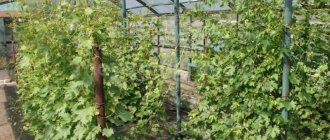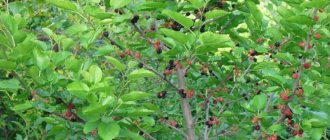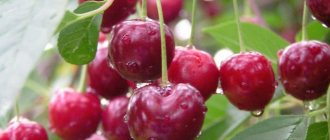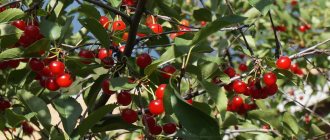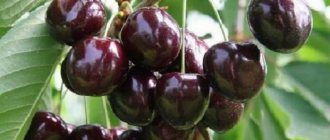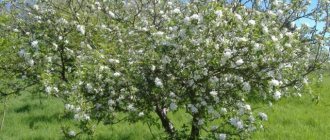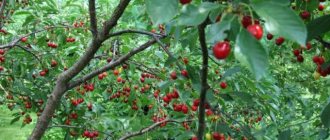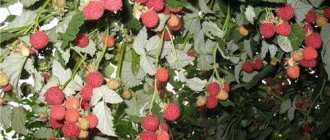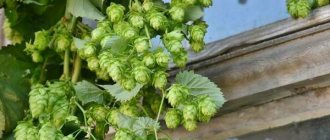This became possible, first of all, thanks to American breeders who “domesticated” wild forest berries, leaving all the beneficial properties of black peas in new varieties and providing them with new modern functionality.
Fact: Blueberries are one of the most productive, durable, productive, resilient and useful plants in the world.
Garden blueberry is a tall, abundantly fruiting plant. This crop is ideal for cultivation in the Moscow region, as it has adopted a special vitality from its wild relative. It is known that in the wild the shrub grows mainly in northern latitudes, in particular in Iceland, North America, and Siberia. “In her blood” is the ability to withstand frosts down to -35 degrees, sudden changes in temperature, wind and waterlogging, since blueberries’ favorite place is marshy areas.
The modern blueberry plant does not have such a long life cycle as those found in the wild, but over the years of productivity it becomes fully active and produces simply excellent harvests. So from one bush you can collect 10-12 kilograms of blue berries, which are superior in size and juiciness to natural ones.
Homemade blueberries begin to bear fruit relatively early - already at 2-3 years of age, while its ancestor enters the productive period only at 15 years of age.
A significant disadvantage of garden blueberries is their short life span. After just six years of active fruiting, the plant’s productivity decreases sharply. This is manifested in the low quality of crushed berries and their small quantity. Note: blueberries growing in nature can bear berries for 50 years. You can continue the blueberry genus by regularly propagating it in various ways.
Fact : Wild berries contain more vitamins than domesticated ones.
The best productive varieties for the Moscow region
Only enterprising people take the risk of growing blueberries, who receive great benefits by selling such a rare and extremely useful product. Naturally, it is possible to grow berries solely for pleasure, however, this process is quite troublesome and painstaking. The correctly selected variety that meets all the requirements of the growing region will help make the task easier. Early varieties of garden blueberries are optimally suited for the middle latitudes of Russia. They must also be frost-resistant, withstand troubles associated with an uneven climate, and be immune to various diseases. Experts also recommend giving preference to tall varieties. In all respects, varieties of American selection are suitable for the Central region:
| variety name | characteristic |
| Bluecrop | Medium ripening variety. The bush is compact with a small number of shoots, reaches a height of 180-200 centimeters. Blue berries are distinguished by their large size, great juiciness and tart taste. The yield is above 9 kilograms per bush. Frost- and drought-resistant variety. |
| Patriot | Begins to bear fruit in mid-July. The bushes have a height of 150 cm. Large fruits have a balanced, delicate berry taste. The plant has a high shoot-forming ability, so regular pruning and thinning of the bush is required. The branches are often overloaded with fruits. It has the ability to self-pollinate, but is also capable of cross-pollination. Productivity – 10 kilograms per plant. The variety is winter-hardy, has high resistance to viral diseases, and is not afraid of humidity and drought. |
| Northland | The harvest ripens in July. The bushes are of medium height, growing just over a meter. They produce a stable annual harvest (up to 8 kilograms) of medium-sized but very sweet dark blue berries. With the correct formation of the crown, the bushes acquire a decorative character. Look great placed along a hedge or fence. |
| Northblue | A low-growing shrub (up to a meter high) overgrown with dense dark green foliage and numerous shoots. The berries have a good taste and can be stored for a long time. Harvest occurs in mid-August. The variety has high frost resistance, feels comfortable in the Moscow region and at the same time shows good yield indicators - 9-10 kilograms per plant. |
| Bluejay | An early variety that produces powerful, spreading, two-meter bushes, which during intensive fruiting are densely hung with berry clusters. The fruits are large, light blue in color with a whitish tint. They do not crack, are stored for a long time, and tolerate transportation well. The first berries ripen at the end of June. Productivity – up to 4 kilograms. Bluejay is immune to various diseases. Tolerates frosts down to -33 degrees. The variety is used mostly for commercial purposes. |
| Chippewa | The variety is not afraid of frost and disease. Ideal for cold and rainy areas. The bushes are of medium height, compact, with straight upward growing shoots. The fruits ripen early. They are large in size with firm light blue skin and a tart aroma. The yield from one bush is on average 6 kilograms. |
| Nelson | The fruits have excellent taste, for which the variety has become very popular among consumers. Late variety - fruiting occurs in August. The plants take root well in any area and produce an annual 6-kilogram crop of large, sweet berries. The bushes reach a height of 1.6 meters. They are spreading, powerful, densely leafy. They are rarely exposed to diseases and pests. |
| Duke | Each Duke blueberry bush produces up to 8 kilograms of selected fruits already in July. Varietal plants are tall (up to 1.8 meters), spreading; during the ripening period, the branches, overloaded with fruits, droop towards the ground. To prevent them from breaking, they must be tied up. Important features of the variety: it blooms late, it is demanding on the level of humidity (there should not be a lot of moisture), the fruits are ideal for fresh consumption. |
| Blugold | The berries appear early and enter the stage of biological ripeness already in mid-July. The variety is unpretentious and even with minimal care and in bad weather conditions it produces at least 5 kilograms of high-quality harvest (maximum yield is 7 kilograms). However, if the fruits are not removed in time, they dry out quickly. The bushes of the variety are branched, occupying a lot of space, up to 150 centimeters high. The berries are medium-sized, sweet and juicy. Blugold plants are not afraid of frost and a number of diseases. Excellent for growing in the northern parts of Russia. Disadvantage of the variety: overripe berries fall off easily. |
| Bonus | Large-fruited early blueberry variety. The tall bushes are very spreading, densely strewn with delicate white flowers during flowering, and with clusters of fragrant berries the size of a coin when fruiting. The berries are sweet and juicy. They do not crack or wrinkle during transportation and are stored for a long time. The variety is high-yielding and produces up to 8 kilograms of selected goods annually. |
| Herbert | The fruits are quite large, have a rich taste and bright aroma. The height of the bushes reaches more than two meters. They rarely get sick and easily tolerate even the most severe frosts. In the most productive year they produce up to 10 kilograms of fruit. |
| Elizabeth | Perhaps the berries of this variety are the most delicious and aromatic of all. The fruits are large, with an unusually beautiful bluish-white tint. Fully ripe, they are collected in huge clusters and await harvesting without falling off or cracking. Fruiting occurs in August and lasts unevenly. The berries form and ripen gradually until September. The advantage of the variety is its easy and successful propagation by lignified cuttings. For healthy development, plants should not be planted on sandstones. They prefer loose and fertile soils. Under ideal conditions, Elizabeth's yield reaches 6 kilograms. Please note : The Elizabeth variety is named after the American Elizabeth White , the “progenitor” of garden blueberries. |
Varieties suitable for the Moscow region
The two most famous types of blueberries are:
- marsh blueberry (low, marsh);
- high blueberry.
Both species are common in areas with cool and short summers. The average height of the bushes is 50-70 centimeters. Garden forms are taller and more productive, reach a height of 1.5-2 meters and produce up to 10 kilograms of berries per bush.
For planting in the country, it is recommended to choose high blueberry varieties bred in the USA and Canada and having English names. They differ from the low variety by oval shiny leaves and larger sweet berries, up to 2 grams.
The swamp blueberry has a wide wedge at the base of its leaves, the leaf blade is matte, the berries are small and collected in clusters, the yield does not exceed 1.5-2 kilograms of berries per bush.
The fruits of different types of shrubs differ in the composition of nutrients and vitamins:
- marsh - contains 5-6 percent sugar in berries and up to 50 milligrams of vitamin C per 100 grams of product;
- high – accumulates up to 15 percent sugar and 18-20 milligrams of vitamin C per 100 grams of berries.
Beginning gardeners often confuse blueberry and blueberry seedlings, as well as the berries themselves. The main difference is that blueberries grow as a creeping bush, young shoots are green, without bark, and the berries are located singly on a branch. Blueberries have erect, lignified branches, the fruits grow in clusters, and the juice of the berries is lighter in color compared to blueberries, which stain the hands with dark blue juice.
Site selection
Although blueberries grow in “wet” places in forest conditions, this does not mean that you need to choose the wettest place in the garden. Absolutely not - the area should be well-lit, level, possibly with close groundwater. The abundance of sunlight will contribute to the formation of larger, juicier and sweeter berries. In the shade, you will get a small and modest harvest, and an unpleasant acid will appear in the taste of the fruit.
The place should also not be draughty, since cold winds quickly damage the bark on thin branches and infection can get inside the plant. There should be no tall trees or shrubs near the blueberry bushes - this can cause competition for soil nutrition, in which the blueberry will quickly lose due to its shallow roots.
Landing rules
The initial stage of growing blueberries is proper planting. First of all, you need to decide when it is better to plant - in spring or autumn. If we talk about the peculiarities of planting in the Moscow region, it is better to choose the autumn period. Frosts come to this region quite late, so the seedlings have time to take root. If you plant blueberries in the spring, there is a risk that return frosts, typical for the region, can destroy the young plants.
Selecting a location
To plant blueberries, you need to choose a well-lit area . It is advisable that the crop is not disturbed by strong winds, which will cause brittle branches and falling of ripe berries. The area should have an average level of humidity. Do not be guided by the fact that in nature blueberries grow in swamps - and there they “select” areas on higher elevations. Overhydration can lead to serious illnesses.
Be careful when planting shrubs in a young garden. The surrounding trees will not create shade at the initial stage, but over time they will grow, and the lush crown will block the sun’s rays from the blueberries, as a result the bushes will have to be replanted.
Soil preparation
Blueberries are not picky about the soil composition - even the poorest soil is quite suitable for it, but to improve the yield it is better to make adjustments. Experienced gardeners change the composition of the soil before planting - remove its top layer to a depth of about 20 cm and fill the area with a mixture of high-moor peat, river sand and pine needles collected from the forest. Sand and pine needles are taken in equal proportions, and peat should be 5 times more.
Acidic soils are preferred for the crop. Most likely not even for herself, but for the mycelium of the fungus with which the blueberry roots are entwined.
Fungal spores take all the necessary nutrients from the soil and transfer them to the bush, which, in turn, feeds the fungus with its sap. The absence of acid negatively affects, first of all, the vital activity of the mycelium, which also affects the plant itself. Did you know? Blueberries are most popular in the USA and Canada. 20 festivals are held there annually, where many dishes prepared with this berry are exhibited.
Before planting, it is advisable to acidify the soil: you need to dilute 50–70 g of 9% vinegar essence in a bucket of water - this is enough for 1 m². Instead of acid, you can use sulfur (40–60 g per 1 m²) or dilute 2 tbsp. spoons of citric acid in a bucket of water.
Planting pit
There are two ways to plant blueberries - in a trench or in a separate planting hole. If we are talking about one or several bushes, it is more convenient to dig holes. Each of them should have a depth of about 30–40 cm and a diameter of half a meter. The distance between plantings should be at least 1.5 m.
A layer of polyethylene is placed at the bottom of the planting pit, which will block the natural soil of the site from entering. Now you need to fill in the soil composition with high-moor peat, which was mentioned earlier.
Find out when and how often blueberries bear fruit.
For planting, 2-year-old seedlings are chosen, preferably with a closed root system. The bush needs to be planted in a hole and the roots should be spread horizontally. It is sprinkled with soil, watered abundantly (8–10 liters of water) and mulched with pine sawdust and pine bark.
Planting in open ground
Blueberries can also be planted in open ground - this is usually done when planting in trenches. To do this, dig a ditch 50 cm wide and about 40 cm deep. The length will depend on how many bushes you plan to plant, since the distance between them must be at least 1.2 m.
Important! If planting is planned in an area with close groundwater or close to wetlands, you need to plant blueberries not in trenches, but on ridges. To do this, they form a long hill rising 20
–
30 cm above the soil surface.
The soil mixture is poured into the bottom of the trench and acidified. It is better to carry out this procedure in advance - 2-3 days before planting. Now, in the places where the bushes will be located, small hills are formed on which the seedlings are planted. After this, the trench is filled up, the planting sites are watered abundantly and the tree trunk circles are mulched.
Correct soil
The ideal soil is peaty or loamy, with good aeration and water permeability, since stagnation of water will immediately cause the death of the roots located at the soil surface. Seedlings should grow on a layer of drainage (sawdust, spruce branches, sand).
Please note : it is better if nothing was grown on the site for several years before planting blueberries.
A prerequisite for successful growth of the crop is acidic soil. The pH level should be between 3.5-5.5 units. If the area does not meet the requirements, it must be acidified with sulfur or citric acid.
When preparing the soil, one part sand and three parts peat are added to it. Fertilizers include complex minerals that contain equal amounts of nitrogen, phosphorus and potassium. You shouldn’t add organic matter - blueberries are not very popular.
Please note: clay and loamy soils are not suitable for growing blueberries.
Landing dates
To grow blueberries in the Moscow region (planting and care are described in the following sections), you must first decide what time of year is best to plant this crop so that it takes root better. Typically, most professionals prefer to do this in the fall or spring. The second option is the most preferable, because in this case the blueberries will have time to produce a harvest this year, especially if the planting was done in April.
Planting blueberries in the fall also has some benefits. For example, the plant will be able to better withstand the first frost because it will initially be planted in harsh conditions. However, caring for crops at this time of year is characterized by certain difficulties. Indeed, in some cases, cold snap in the Moscow region begins already in early November. Therefore, it would be preferable to carry out the procedure in September so that the blueberries have time to adapt.
Landing technology
Blueberry seedlings are planted in deep holes (up to 50 centimeters). The dimensions of the pit are 50*50 centimeters. The hole is supplied with the prepared soil mixture, taking into account that it should not contain ash - the plant does not like this. Further:
- 2/3 of the pit should consist of a loose and fertile substrate of peat, sand, sawdust or pine needles. It also includes turf soil. It is important that this soil composition is acidic.
- Table vinegar or citric acid add acidity to the soil. You can also buy a special oxidizing agent in the store. However, you should not be overzealous with acidity - at a pH level above 5 points, there is a high probability of plants contracting chlorosis.
- Don't forget about mineral fertilizers. They should contain a large dose of phosphorus and potassium. Nitrogen-containing preparations are chosen with a high concentration of sulfur. Organics are not added.
- Blueberry plantings are usually arranged in rows, leaving a gap of 1-1.5 meters between the bushes.
- Before planting, the seedlings are well watered so that the soil in which they are located is wet and the roots can be easily untangled. The root system of blueberries is very fragile - the roots are thin and long.
- Having pulled the seedling out of the container, the earthen ball is broken, and the roots are carefully untangled. If this is not done, they will lose the ability to grow.
- The bush is immersed in a hole, the roots are carefully straightened to the sides and covered with soil mixture. When planted correctly, the root collar should be buried three centimeters. There should be a small depression left under the seedling in order to place a layer of mulch there. But first, blueberries are watered abundantly and only then bark, straw, and pine needles are added. This will help retain water in the soil longer.
Please note: I use acidified water for irrigation.
In autumn, planting is carried out according to the same principles as in spring. All weak shoots are cut off from young growth, and healthy shoots are shortened by ½ part.
Planting blueberries
Blueberry seedlings must be planted in well-lit areas that have an acidic soil reaction. If the soil does not have an acidity of 3.5 to 5, it needs to be acidified. To do this, water the soil with a solution of citric acid (2 tsp per 8 liters of water), or a 9% solution of vinegar (100 ml per 10 liters of water).
The soil must be dug up and freed from stones and weeds. The site should be protected from the wind; blueberries are recommended to be planted near fences and outbuildings.
It is best to purchase seedlings in containers and cuttings at least 50 cm long. Such seedlings have better survival rate. Blueberries can be planted in holes, trenches or ridges. Regardless of the method, before planting seedlings, you need to prepare a special substrate that will be used to fill trenches or holes.
To prepare the substrate, you need peat and sand in equal proportions. For one bucket of the mixture, add 50 g of pine sawdust, chopped pine needles and superphosphate.
In the prepared area, it is necessary to make a given number of holes, taking into account that low-growing varieties are planted 50 cm in a row and 150 cm between rows. Medium-sized ones are planted 100 cm in a row and 200 cm between rows, and tall ones 150 cm in a row and 300 cm between rows.
Holes are dug to a depth of 40-45 cm, the previously prepared substrate is laid out at the bottom, the seedling is removed from the container, and carefully straightening the roots, it is planted in the ground. The remaining space of the hole or trench is filled in layers with substrate and ordinary soil. After which they are lightly tamped and watered abundantly, after which the blueberry seedlings must be mulched - covered with 3-5 cm of softwood sawdust or acidic peat.
There is also autumn planting. With this method, there is a danger of young seedlings being damaged by frost, so blueberries are planted in the fall only when it is known for sure that the winter will be mild and snowy.
Transplanting blueberries to a new place
It is preferable to replant shrubs at the age of two, when they reach half a meter in height. Before digging, remove all the resulting shoots and buds. This time the plants are planted a little deeper than they grew before, but no more than 3-5 centimeters. It is important that all roots are underground.
The soil does not need to be fertilized frequently; it is enough to fill the soil once with full mineral fertilizer in early spring during the growth of greenery and shoots.
When it blooms and bears fruit
Blueberries begin to bloom and bear fruit in the 3rd year after planting. The first buds appear in early May. Gradually opening, they form pretty white or white-pink bell-shaped flowers. One fruit branch can produce up to 40 buds, which will soon be replaced by berries.
Fruit ripening occurs at the beginning of August, but with proper care it can be earlier - sometimes harvesting begins at the end of July. The berries ripen in large hanging clusters, but not together - on one bush there can be both unripe and very ripe fruits. The bushes bear fruit throughout the month. The yield of blueberries increases over the years - by the age of 7, you can collect up to 8 kg of berries per season from one bush.
The fruits are round, slightly elongated berries of blue-black color. There is a waxy coating on the skin, which well retains the moisture and integrity of the fruit. Garden blueberries are famous for their pleasant sweet taste and aroma. The berries are quite large - in some varieties they reach a weight of up to 1.8 g with a diameter of 14 mm (wild blueberry fruits have an average weight of 0.8–1.2 g).
Blueberry care
So, the most important thing has already been done: healthy seedlings have been purchased and proper planting has been done. Next, you need to provide regular care for the blueberry plantings and wait for the first harvest.
The soil around the bush should always remain loose and light, slightly moist. True, there is no need to be overzealous with loosening, otherwise you can dry out the soil. You also need to remember that the root system of a blueberry bush is superficial, which means there is a risk of hitting the roots with a hoe. Shallow (up to 8 centimeters deep) loosening is sufficient. It is better that the area under the bush is mulched. Mulch has a number of properties necessary for blueberry growth:
- it retains moisture;
- prevents weeds from growing;
- protects roots from overheating;
- By rotating, it nourishes the earth with vitamins and minerals.
Depending on the variety, blueberries may suffer from proximity to weeds or garden plantings, so this should also be taken into account when caring for plants.
Watering
Blueberries love moisture, but hate being too humid. Stagnation of water is detrimental to it. The first time after planting, young bushes are watered twice a day, using a bucket of water for each plant. As soon as the seedlings get stronger and begin to grow, reduce watering. In the Moscow region, where the climate is moderate, you can water once every 4 days. Moreover, this should be done even if it has recently rained.
Attention ! The soil should remain moist to a depth of 4 centimeters.
Once a month, an oxidizing agent is added to the irrigation water if the acidity of the soil is weak.
The frequency of watering increases during flowering plantings. This period is important for the future harvest. Untimely irrigation of the bushes will lead to its reduction, and the resulting berries will not have juiciness and sweetness.
Please note: on hot days you need to additionally spray the leaves and twigs of the bush.
Top dressing
In the first year of life, blueberries do not need additional nutrition - they have enough of what the earth is currently rich in. By the second year, the smell of nutrients is depleted, which is when they begin to regularly apply fertilizers. For full development and good productivity, plants need vitamins and minerals, which are contained in complex preparations.
Nitrogen is necessary for shoot growth and fruit formation. Plantings are treated with nitrogen-containing compounds three times per season. It is arranged before fruiting begins (in early spring, in May and mid-June).
Phosphorus supplements improve the viability of blueberries and increase productive functions. Shrubs are fed with phosphorites in mid-April and June.
Potassium increases the protective functions of plants.
A good dose of potassium preparations ensures a good wintering - the roots will not freeze and the plant will not get sick. You need to fertilize blueberries with potassium according to the same principle as with phosphorus.
In the conditions of the Moscow region, blueberries require additional feeding in the spring, namely during the swelling of the buds and another month later. They mainly use ready-made products containing all the ingredients necessary for nutrition, as well as soil acidifiers (Florovit, Target). For young plants, the doses of minerals are small. With age, the concentrate increases.
You should not frequently feed the plants and observe the condition of the appearance of the stems and leaves. If they have changed color or structure, then most likely the blueberries lack one or another substance:
- leaves turn yellow - there is not enough nitrogen;
- the leaves rise up and acquire a reddish tint - there is not enough phosphorus;
- the ends of the leaves turn black - it is necessary to add potassium;
- young tops turn blue - the plant needs boron.
Blueberry fruits develop on last year's growth. That is why blueberry bushes need to be pruned only in early spring, before the buds open. You should not do this in the fall, as there is a possibility of cutting off high-quality, good branches with fruit buds. In this case, there will be no harvest next year.
Trimming
Like any shrub, without formation, blueberries quickly grow and turn into lignified, impenetrable thickets. If plants are not pruned annually, they will often get sick and produce weak offspring.
Please note: cutting can be done in early spring or autumn, when the leaves have fallen. The main thing is that the plant is in the dormant stage.
The formation of the crown and skeleton of the bush begins in the third or fourth year of its life. To do this, remove from the plant all the small, numerous growths formed in the lower part of the bush. They also remove diseased and broken branches growing in the wrong direction, as well as asexual shoots. The center of the bush should not be very thick - this contributes to poor ventilation, which inevitably leads to the appearance of diseases. Only strong and durable stems growing upward to the sides are left on the bush.
Tip: if blueberry bushes bloom in the first year of life, cut off the buds so that the plant continues to develop properly.
Next, every year it is necessary to maintain the plant in a “clean” state and carry out regular formative pruning, the purpose of which is to correctly distribute the forces of fruit-forming shoots. All shoots that create density, as well as those lying on the ground, are mercilessly broken off. 5-6 year old large faded branches are also removed.
To stimulate the growth of young growth and increase productivity, shrubs from 8 years of age are subjected to anti-aging pruning. Blueberries are freed from old and unnecessary branches, weak and diseased shoots.
Tip: if you do formative and rejuvenating pruning in the fall, pinch out vigorous shoots in August.
Features of watering
Watering blueberries
The culture is classified as a moisture-loving plant. But if moisture stagnates in the root system, it may die. It is recommended to water the seedlings after two to three days. If the weather is hot, the intensity of watering should be increased. During this time, watering should be done every day. If it rains regularly, then the bushes are watered once for 10-14 days. To prevent rotting of the root system, the degree of soil moisture should be regularly determined. If the ground is wet at a depth of 10-15 centimeters, then you should water the shrub less often.
Caring for blueberries in open ground involves monitoring the humidity of the area during the period when buds are forming and the berries are ripening. With enough moisture, the berries will be tasty and aromatic. To maintain soil moisture, it is recommended to mulch the area. To do this, use peat, sawdust or special material. You can also protect the ground from weeds in this way.
You also need to pay attention to the temperature of the water you are going to water the bushes with. It should be barely warm. This will help reduce the risk of developing various diseases. It is better to water with water from a special barrel in which it was kept during the day. Watering is usually done late in the evening. To avoid burning the delicate leaf blades, water should be poured directly onto the ground .
Preparing for winter
Wild blueberries can withstand frost – it’s in their genes. Growing even in the northern regions, it is not afraid of even severe frosts. The domestic berry has taken over its vitality from its parent, however, in particularly cold and snowless winters, young branches of shrubs may still freeze. This may happen more due to the unbalanced composition of the fertilizers that fed the plant in the summer. An excess of nitrogen in the soil leads to failure of young animals to mature. Annual stems have a dense and hollow structure. Because of this, they freeze in winter. To prevent this from happening, fertilizing with nitrogen is carried out only in spring and early summer.
To ensure that the soil, and therefore the roots, do not freeze before wintering, it must be provided with a large amount of moisture. The soil should be moistened to a depth of 35 centimeters. In the fall, the layer of pine needle mulch is replaced with a new one, and the area under the bushes is covered with it. If the blueberries are still very young, then for the winter you can cover the bush with completely breathable material. Mature bushes no longer need such protection.
Fact : blueberries bloom in spring even at -10 degrees.
Rules of care
The condition of the bushes and the future harvest greatly depends on the care of the plantings. Proper agricultural technology allows you to obtain good yields from a plot planted with blueberries for several years.
Soil irrigation
Of course, when watering you need to pay attention to the weather in the region. Blueberries are watered 1-2 times a week, adding 1.5-2 buckets of water to each bush. Do not allow the soil to become waterlogged or dry out.
Mulching, weeding, loosening
The soil under blueberry bushes in a summer cottage is mulched with pine sawdust or chopped pine needles; they retain moisture and provide additional fertilizer for the plantings. It is weeded under the bushes, removing weeds, and carefully loosened, trying not to damage the roots.
Trimming
The plant is pruned from the third year after planting. Remove lower branches, damaged or dried branches. After 5-6 years, the bushes are thinned out, old branches and old axial shoots are removed, and the bush is not allowed to thicken. Sanitary pruning is carried out in early spring, before the buds swell.
Disease and pest control
If agricultural practices are violated, plants may become sick. If there is an excess of moisture, fungal infections and other diseases are possible:
See also
13 best varieties of olives and how to choose the right delicacy
Read
Gray rot
The disease occurs when there is excess humidity and high temperature. Bush branches, foliage and berries are affected. First, yellowish dots form, then they grow, a gray coating appears, and the infected parts of the plant die.
For protection, you need to remove fallen leaves and twigs under the bush in the fall.
In late autumn and early spring, plants are treated with copper sulfate or Bordeaux mixture. Can be used for spraying Topaz, Skor, following the manufacturer's instructions.
Stem cancer
Reddish spots that appear on the branches of the bush grow, and the shoots die. To protect against the disease, the bushes are treated with Bordeaux mixture, Topsin.
Fruit rot or moniliosis
The disease affects berries and blueberry bushes. Bordeaux mixture is used for protection. For prevention, fallen leaves are carefully raked out from under the bushes and the bushes are sprayed with Bordeaux mixture in late autumn. Additional treatment is carried out in early spring, before the buds begin to swell.
Protection from diseases and pests
Blueberries have strong immunity to many serious diseases, but cannot cope with such a dangerous disease as stem cancer. The first symptoms of the disease appear unexpectedly - the leaves become covered with red spots, which spread like lightning throughout all parts of the plant. Unfortunately, even strong fungicides cannot defeat cancer.
Diseases can only be fought through prevention. In the spring, blueberries are sprayed with a 3% solution of Bordeaux mixture, and the bushes are irrigated 5-6 times with Fundazol (the first three times before flowering, the next after harvesting the fruits).
Often stem cancer can be confused with another insidious enemy of garden blueberries - Phomopsis. This is a fungal disease that dries out young shoots. Affected stems must be cut off at the root and burned to prevent the spread of the fungus. The appearance of the disease can be avoided by treating it with fungicides in the spring.
Fact : Blueberries have low resistance to fungal diseases.
Numerous pests love to feast on strawberries. Birds cause the main damage to the crop. To protect the berries, the bushes are covered with netting.
You can often find the cockchafer on bushes, which feeds on both leaves and flowers, and the larvae located in the ground eat the roots. You can get rid of the beetle with the help of insecticides, as well as using folk remedies - for example, setting up sweet traps and sprinkling the ground with onion peels.
Disease and pest control
Blueberries themselves are an unpretentious crop, but they are also susceptible to various diseases and pests.
See also Features of storing blueberries for the winter, fresh and frozen
Main fungal diseases:
- gray rot - initially the fruits are affected, and then the entire bush;
- stem cancer - the plant dies completely;
- fruit rot - leaves, branches, flowers and fruits are affected;
- physalosporosis is a disease that leads to the death of shrubs.
The main reason for the occurrence of fungal diseases lies in improper watering. When there is an excess of moisture, stagnation occurs in the root system.
Stem cancer
Blueberries are also susceptible to viral diseases:
- threadiness of branches - the whole plant is affected;
- spotting - the disease affects the leaves;
- dwarfism - the entire plant is affected.
Treatment for these diseases is quite lengthy and most often the bush simply dies.
Blueberry pests:
- caterpillars - eat leaves;
- bud mite – its diet is plant buds;
- aphids – suck out nutrients;
- flower beetle - attacks flowers and buds.
In the presence of diseases, special means are used. The most commonly used are Topsin and Euparen.
Expert opinion
Stanislav Pavlovich
Gardener with 17 years of experience and our expert
Ask a Question
Important! In spring, plants can be attacked by cockchafers; to protect the bush, it should be sprayed with Actellik or Karbofos.
Harvesting
Fruiting in young blueberry bushes occurs in the third year after planting. The first fruits appear in mid-summer. The berries are collected in huge bluish clusters, strewing the spreading bushes. When ripe, they can hang on the bush for a long time without falling off or spoiling. The harvest can be extended by periodically removing fully ripe berries into dry containers. The dense skin of the berries does not allow them to burst or wrinkle, which makes transportation easier. Berries can be stored in the refrigerator for almost a month, and in room conditions for 7-10 days.
Reference : blueberry fruits have an astringent effect, and therefore they are used in the form of infusion, decoction, jelly and fresh as a remedy against diarrhea and inflammation in gastrointestinal diseases. Blueberry leaves, due to the presence of the glycoside myrtilline, which has the property of lowering blood sugar levels, have been proposed for the treatment of diabetes. Everyone also knows the positive effects of this berry on vision.
Harvest and storage
Harvesting takes place in several stages. The berries are harvested in dry weather, as wet ones are very poorly stored. Unripe fruits are better preserved and transportable, as they have a denser skin. However, this is not the best option for fresh consumption and making jams, since the taste of the berries is predominantly sour. The berries become sweeter as they ripen.
At the same time, the thickness of the skin becomes thinner and the fruit becomes more fragile. They need to be collected carefully, and it is advisable to wash them immediately before use or processing. The fruits can be stored in the refrigerator or cellar, spread out in a thin layer in a plastic container. Ripe berries can be stored in this way for up to 5 days, and those collected in the early stages - up to 10–12 days.
There are several ways to save blueberries for a long period, until next year, namely:
- freezing - the fruits are placed in plastic bags or plastic containers and placed in the freezer;
- drying - the berries are left in a dark, ventilated room or placed in the oven, where drying occurs in 2.5–3 hours at a temperature of +50...+60°C;
- soaking - the fruits are placed in jars, filled with cold water and pasteurized for 20–30 minutes (depending on the container), then rolled up;
- sugaring - the berries are ground in a meat grinder, sugar is added (0.5 kg of sugar per 1 kg of fruit). The mixture is heated well, placed in jars, pasteurized, and rolled up.
In all cases, except for freezing, the fruits should be stored in a cool place - in the refrigerator or cellar. Also, fresh berries are used to prepare preparations for the winter in the form of preserves, compotes and jams.
A large selection of garden blueberry varieties bred by breeders allows you to choose the best option for growing at your summer cottage in the Moscow region. Compliance with the rules of planting and care, in turn, will contribute to the high yield of shrubs, which, moreover, have a fairly long life span, reaching up to 80 years.
Blueberry propagation in the Moscow region
As already mentioned, unlike its wild relative, garden blueberries have a very short life cycle. Starting to bear fruit only from the second or third year of life, by the age of six the plant degenerates - the berries become very small and their quality deteriorates. You can preserve the plantation by regularly propagating varietal plants. You can replenish your collection of tasty and healthy berries in various ways: vegetatively (layers, cuttings) and seeds.
Vegetative (asexual) propagation is the most effective and fastest way to increase the number of blueberry bushes. Most often, gardeners choose the cutting method, which allows them to quickly grow healthy and strong seedlings that will bear the first harvest within a year.
Necessary conditions for cultivation
The main and basic condition for growing blueberries in the country is planting in acidic soil. In other areas, blueberry bushes will not grow or bear fruit. The berry does not tolerate low-lying and waterlogged areas.
Garden blueberry varieties are hybrid, self-pollinating, but for better yields it is better to have several bushes on the site.
It is useless to grow berries from wild forest seedlings in a garden plot - they do not take root. To get a harvest, you should buy varietal plants suitable for weather conditions near Moscow.
See also
Diagram and how to properly prune blueberries for beginners
Read
Green cuttings
It is best to use young shoots grown this year as seedlings. With age, the shoots become woody, they contain less water balance, and their metabolism is worse. Old branches take longer and take root less well. Seedlings from green cuttings develop much faster, since newly born shoots are able to quickly grow roots.
Planting material is harvested at the end of June (from the 20th) - early July (until the 10th). When harvesting shoots, special attention should be paid to the timing of the propagation operation, since if the shoots are not mature enough, they will hurt and may dry out. This is due to the fact that their vegetative stage of development has not yet been completed, and the plant does not fully receive and distribute nutrition along the stem and other parts. And if you are late in taking the cuttings, they will “outgrow” and their roots will take a very long time to grow.
Young green branches up to 18 centimeters long are cut off along with the leaves and heel (the remnant of last year's wood at the cut end). The lower leaves are torn off, leaving only the apical foliage. Cuttings are rooted in greenhouse conditions in a moist mixture of peat, sand and humus. With proper care, which includes treatment with fungicides, watering, ventilation and maintaining temperature conditions, the seedlings will grow strong roots within 40-45 days. Rooted seedlings are planted in a permanent place in early autumn. For the winter, plantings are securely covered with warm, breathable material.
Pests and diseases
Agricultural technology for garden blueberries in the Moscow region includes protection from diseases and pests. The culture has high immunity and is rarely damaged. Diseases and insects spread when plantings are dense and humidity is high. Therefore, special attention is paid to bush formation and watering.
In the rainy summer in the Moscow region, blueberries show signs of fungal diseases: gray rot, spotting, moniliosis. They are detected by dark spots on the leaves, fruits and shoots that dry out ahead of time. Affected bushes are treated with Topaz or Hom. Affected plant parts are removed and burned.
Advice! Chemicals are abandoned if there are less than 3 weeks left before harvest.
The most dangerous pests for blueberries in the Moscow region are caterpillars, leaf rollers, scale insects, and aphids. Insecticides Actellik, Karbofos, etc. are effective against them. For prevention, bushes are dusted with tobacco dust or ash.
Propagation by lignified cuttings
Many gardeners successfully breed blueberries using woody cuttings. These are annual shoots that have a high ability to take root and produce plants while maintaining all varietal characteristics. Cuttings for seedlings can be prepared in advance, for example, at the beginning of winter, in order to plant them in the ground in the spring. The shoots can also be cut in the middle of winter - the main condition is that at this time the plant is in the dormant stage. Cuttings are selected only that are strong and healthy, without signs of disease and mainly from the lower branches. They should contain several dormant, intact buds (at least three). Store them in the refrigerator or in the snow - as you like.
Please note : the lower cut is made under the bud at a slight degree, and the upper cut is made 1 centimeter above the bud
.
To stimulate root formation processes, it is recommended to treat the cuttings with a growth stimulant and initially keep them in a greenhouse in a moist peat-humus substrate. It is important to maintain high humidity not only in the soil, but also in the air and not allow the cuttings to dry out. The seedlings take root within one and a half to two months. When the seedlings gain strength, they can be moved to a permanent place of residence.
Reproduction methods
Seedlings today are expensive, but the berries are very tasty and nutritious, and many gardeners decide to grow the crop themselves. This process is labor-intensive, but it’s worth it if you want berries to grow in your garden plot. There are three types of blueberry propagation.
Cuttings
Branches for propagation are cut off in winter. These should be annual shoots with a diameter of 0.5-1.2 centimeters; they are stored until spring in the cellar or basement. Branches for propagation are placed in a box with sawdust or peat.
The prepared branches are cut into pieces 8-10 cm long. The upper cut is made straight, and it should be 2 centimeters higher from the bud. From below, the cutting is cut diagonally just below the bud. The lower cut is treated with a growth stimulator. Rooting is carried out in containers filled with peat or sawdust.
Seeds
Seeds are planted in peat with mixed sawdust in early December. The soil must be moistened before sowing. The container is covered with glass and wrapped in a plastic bag, placed in the refrigerator on the bottom shelf for 3 months. Once a week, the seeds are ventilated and, if necessary, moistened.
In March, the crops are placed on the windowsill, where the sunny side is. After 2 weeks, the first shoots should appear. Then the crops are grown as ordinary seedlings.
By layering
The branch is tried on in the place where it will be buried. A small groove of 6-7 cm is made in the ground. Shallow cuts are made in the branch in the place where it will come into contact with the soil, and it is treated with a preparation for root formation. The branch is attached to the ground with wire and pressed down with a brick or stone.
The soil in this place should be moist all summer. Next spring, the branch is dug up, and a cutting from the mother bush is cut from it. Rooting of branches occurs within 2-3 years.
Conditions for rooting
The cuttings should be in the ground so that 1-2 buds remain on the surface. The room temperature should be at least 22 degrees. Air humidity – 70-80%. Roots begin to form within a month. Only then will it be possible to remove the film from the greenhouse and carry out frequent ventilation. After another 3-4 weeks it will be possible to fertilize with ammonium sulfate. Ready cuttings are planted in a permanent place in the spring, as soon as the earth has thoroughly warmed up and the air temperature does not fall below 0 degrees.
Fact: Blueberry survival rates are very low at only 25%.
Subtleties of care
Even if you planted blueberries in compliance with all the rules, this does not mean that the crop will take root well and will produce a large harvest over time. We still have to work on this, providing the bushes with proper care.
Watering
Good soil moisture in July and August will ensure a good harvest not only this year, but also the next, since moisture promotes the formation of new flower buds. During this period, blueberries need to be watered 2 times a week, twice a day after lunch. A portion of one watering for a bush is 10 liters. On particularly hot days, you can add evening spraying, which will reduce the plant’s stress from overheating and speed up photosynthesis processes.
To maintain soil moisture, it is mulched . For blueberries, it is better to use rotted pine sawdust and pine bark as a mulching material. Such a shelter will not only conserve moisture and protect the soil from overheating, but will also “slow down” bud opening in the spring, helping to cope with temperature fluctuations.
Selection of fertilizers and feeding
Mineral fertilizers are ideal as fertilizers for blueberries: complex formulations can be purchased in the store. One of the best is the Polish fertilizer “Florovit” (30 g per 1 m²), which contains many nutrients and is completely free of nitrates. You can also independently prepare a composition of 100 g of superphosphate, 50 g of potassium sulfate and 60–70 g of ammonium sulfate (dose for 1 bush).
Bushes are fed in spring, summer and autumn to improve growth and fruiting. The first feeding in spring is carried out in mid-April and repeated 3 times at intervals of a week. In summer, blueberries are fertilized after flowering to increase the quality and sugar content of the fruit. In the fall, after harvesting, it is advisable to feed the bushes to restore their strength, which will be needed for laying new flower buds and a safe winter. Before applying fertilizers, the soil must be well watered - this will allow the compounds to be absorbed into the soil faster.
Reproduction by layering
For unhurried summer residents and if the blueberry plant has not yet reached its productive age, you can get a new varietal bush using layering. The fact is that reproduction occurs directly on the mother bush. The strongest and longest shoots are pressed to the ground and covered with nutrient soil to a depth of 6 centimeters. There should be 2-3 buds below the surface. This is usually done at the time of intensive plant growth - from April to September. The outermost part, being underground, will eventually become overgrown with a root system.
To ensure rooting is as fast as possible, the necessary fertilizers are added to the soil, watered and loosened. As soon as this happens, the cutting can be disconnected from the general bush, since it itself will become independent. The method of propagation by layering is not so popular due to the length of the process, which takes about two to three years.
Please note: not everyone is able to get healthy and productive offspring due to the weak root-forming ability of this crop.
Garden blueberries are a very demanding and capricious crop. Not all gardeners can grow it. This is due, first of all, to little knowledge of the agricultural technology of this useful plant, which summer residents began to develop in their gardens relatively recently. Caring for and propagating requires a lot of expense and time, but obtaining valuable berries, so rare in our area, is worth it.
Memo: calendar for caring for garden blueberries from spring to autumn
To keep the blueberry plant in order, you need timely feeding, watering, pruning and other procedures. We tell you how to organize crop care from spring until autumn.
Caring for blueberries is strictly tied to the annual cycle of crop development. Agricultural technology includes applying fertilizers, organizing watering, pruning, organizing pollination of the berry garden, controlling the activity of pests and weeds, and harvesting.
From November to mid-March, blueberries are in vegetative dormancy. At this time, caring for it only involves applying autumn herbicides that inhibit the growth of perennial weeds. But with the arrival of spring, the culture gradually comes to life and requires a whole range of measures for full development. The most important stages of caring for a berry garden are presented in the leaflet.
About autumn watering of blueberries
With the onset of autumn, the need for watering is greatly reduced, especially in rainy weather. However, in most regions, in the fall it is recommended to carry out mandatory moisture-charging irrigation, in which the soil layer should be saturated with water to a depth of approximately 40-45 cm.
It is important to note that autumn irrigation activities are always carried out using a special divider, which prevents soil erosion and exposure of the plant’s root system. For example, a three-year-old plant will need to use about five buckets of water.
Spring pruning of blueberries
Date: mid to late March
Without spring pruning, the growth of the berry plant slows down, the number of flower buds decreases, and the berries themselves become smaller. The procedure is carried out from the third year after planting: young blueberries require only sanitary thinning. But already from 4-5 years of age, there is a need to rejuvenate the bush, as well as to prevent its excessive thickening.
Blueberry formative pruning plan (bush 4th year of cultivation and older):
- Trim low, spreading branches close to the ground. Leave only the erect growths.
- Remove weak, oldest and diseased branches from the thickened middle of the bush.
- Remove most of the thin branches, leaving strong skeletal shoots.
- Remove old, heavily branched branches with short growths at the top of strong axial shoots. Leave young branches with shoots of the first and second order of branching.
When choosing a day for pruning, consider the weather in your area. By holding the event too early, you will increase the risk of frost damage to the berry garden. If the pruning is late, the plant will lose an impressive part of the nutrients that move from the roots to the tops of the branches.
Mulching blueberries
Date: second half of March – early April
Mulch creates favorable conditions for the growth of the berry plant and its fruiting. As it decomposes, it becomes a source of easily digestible minerals. In addition, a loose layer of mulch reduces moisture evaporation in summer, and therefore prevents excessive drying out of the soil. In winter, this is an excellent protection for the root system from freezing.
You can mulch blueberries with bark and sawdust from coniferous trees, as well as high-moor peat.
Mulch made from undecomposed organic matter also has certain disadvantages. Firstly, this leads to the need to double the dose of nitrogen fertilizers, because under the layer of sawdust, microorganisms multiply intensively and actively consume nitrogen reserves from the soil. Secondly, undecomposed mulch can become a favorable habitat for rodents.
Blueberry feeding
Dates: March (period of bud swelling), April-May (period of opening of flower and leaf buds); late May – early June (flowering period)
The development of young shoots, roots and leaves greatly depletes the reserves of soil nutrients.
The optimal composition of fertilizer for the first feeding of blueberries: ammonium sulfate, superphosphate, potassium sulfate (proportions 1:2:1).
Complex mineral fertilizers azofoska and nitroammofoska have a balanced composition. The rate of fertilizing increases depending on the age of the bush and for one season is:
- 1 tbsp. for a 2-year-old bush;
- 2 tbsp. for 3 year old;
- 4 tbsp for 4 year old;
- 8 tbsp. for 5 year old;
- 16 tbsp for 6 year old and older plants.
You can also purchase any chlorine-free complex formulations, for example, Florovit for blueberries, Fertika Universal, and apply them according to the instructions.
The rate of mineral fertilizer is divided into three parts. During the first feeding, during the period of swelling of the buds, 50% of minerals are added, during the second, when the buds open, another 30%. The last 20% is left for feeding during flowering.
Do not feed blueberries with manure, compost and other decomposed organic matter. This leads to the death of a special fungus (mycorrhiza) living on the roots of the berry plant. As a result, the bush loses its ability to absorb nutrients and moisture from the soil.
Winter-hardy blueberry varieties for the Moscow region
Sometimes, extremely rarely, in the Moscow region there can be frosts and the temperature can even drop to -30 degrees below zero (on average). There are also varieties of blueberries that feel great in the coldest winters near Moscow.
Nord blue
An interesting blueberry variety with a medium ripening period. Grows small. It is a decorative, compact bush. Maximum height – 120 cm.
It is distinguished by large fruits up to 18 mm.
The color of the berries is dark blue. The taste is good. Ripening time is the first days of August. Subject to long-term storage. For such a small bush the harvest is very good - up to 3 kg. And most importantly - permanent. Withstands -37 degrees below zero.
Blue Giant
The best blueberry variety for the Moscow region in terms of berry size and frost resistance. The taste of this blueberry variety is a bit like cherries. The first fruits ripen within 21 days. This is more of a decorative option, for example, for the Winter Garden. Exudes a pleasant aroma. Blue Jite blueberries take first place in many respects. It is perfectly cultivated on plantations in the future for sale. Frost-resistant blueberry variety.
Chandler
One can definitely say about this variety that Chandler is the most popular in the whole world.
There are several reasons for this:
- high productivity;
- constant amount of harvest;
- ripe berries do not fall off, you can calmly, slowly, collect them within 30 days.
The variety has large berries. Often more than 20 mm in diameter. The bush is lush, with many branches. Pruning is definitely needed. An adult shrub grows up to 1.5 meters in height. Excellent frost resistance and rich harvest are the main characteristics of this blueberry variety.
Legacy
Another high-yielding blueberry variety. From one adult plant you can harvest from 6 to 8 kg. It grows quite tall - up to 2 meters. The fruits are delicious with a characteristic blueberry aroma. The color of the fruit is normal blue with a slight presence of wax. Ripening occurs on August 15 - 16. The harvest can even be harvested mechanically using special equipment. The variety has high immunity and frost resistance.
When does the harvest ripen?
If you grow early varieties of blueberries, you will be able to taste the first berries in mid-summer. Usually the crop is harvested in 2-3 steps. The bulk of the berries ripen at the beginning of fruiting; the first fruits are the largest. The remaining blueberries gradually ripen and are picked from the bush in the next 2–3 weeks.
Hybrids with short ripening periods produce crops earlier than others. They can please you with ripe berries already in the 2nd ten days of July. Mid-season varieties are ready for harvest in early August. Late varieties produce ripe berries starting in mid-August.
Now you don’t have to go to the forest to pick blueberries. It is enough to plant a berry bush on your plot - and you will be able to harvest it without going far from home. The productive age of the crop is 50–60 years. With proper care, garden blueberries will remain healthy and fruitful all these years.
Care after landing
Caring for blueberries after planting involves timely pruning of the bush and treatment against fungal diseases and bacterial rot. Bushes are treated against diseases in the spring, with the beginning of the stormy growing season and in the future, as needed. Insects almost never attack blueberries, so they do not need to be sprayed with insecticides.
The bush is pruned in the spring, after the beginning of the stormy growing season, 2-4 years after planting. It is done with the aim of forming a bush.
Further pruning is necessary in two cases:
- formative pruning of young bushes from 2 to 4 years;
- pruning dried, diseased, weak branches and young growth at the base of the bush.
Pruning mature, mature blueberry bushes will allow you to:
- heavy pruning - get a small harvest of large berries;
- light pruning - get a bountiful harvest of smaller berries.
Thus, the less we prune an adult blueberry bush, the greater the chance of a bountiful harvest.
Landing Features
They are planted in a permanent place in spring or autumn, but spring planting of blueberries in the Moscow region is better, since during the summer period the bush will have time to adapt and prepare for wintering.
Plant the bush in a sunny place, which will be protected from winds and drafts. In windy places, bushes winter worse and freeze out.
You can plant blueberries in partial shade, but in this case you may not expect a bountiful harvest and large berries.
Blueberries prefer acidic soils. This is due to a symbiotic collaboration with a certain type of fungus that actively grows and reproduces only in acidic soils. Therefore, garden blueberries are planted in a hole a little more than half a meter deep, into which acidic peat is added mixed with pine needles, sawdust and sand. It is better not to add humus and ash. If groundwater is close to the site, the planting hole needs to be drained or the blueberries should be planted on bulk beds. It does not tolerate stagnant water well.
If necessary, the soil for planting can be acidified artificially by adding sulfur or using citric, oxalic, or malic acid at the rate of 25-35 grams per 10 liters of water. This solution is poured into the hole for planting blueberries.
The distance between the holes is about 80 centimeters.
The best blueberry varieties for the Moscow region - reviews from gardeners
Anastasia Valerievna, Moscow region. I really love blueberries. It’s great that you can grow it in your summer cottage. I preferred the self-fertile varieties Libberti and Elliot. I planted one tree at a time, because the varieties take up a lot of space on the site. The fruits are tasty and juicy. Medium size, about 1 cm in diameter or so. I planted blueberries here in the Moscow region in early March, so that the roots had enough time to grow and strengthen. In the third year I received an excellent harvest of sour-sweet berries. I eat it fresh. Sometimes I make jams. The yield, I think, is more than 5 kg per tree.
Tatyana Anatolyevna, Khimki Bluecrop variety is my choice of blueberry variety. I chose it because of its high yield and ease of care. Bluecrop is frost-resistant. It also bravely tolerates drought. The berries are medium - 15 millimeters each. The color is pale blue, oval in shape, the taste is more sweet, although there is a slight sourness. Productivity is very good. This is quite enough for our small family. By the way, despite the tallness, the shrub looks quite beautiful on the site, decoratively. In summer it has rich green foliage. In autumn, the bush pleases with fiery burgundy foliage.
Vladimir Grigorievich, Lyubertsy My wife and I have long wanted to plant blueberries at our dacha in the Moscow region, but we didn’t dare. After much thought and careful study of the varieties, we chose an early-ripening hybrid bred in America - Erliblue. Chosen for early ripening. I don't want to wait 4 years to taste the fruits of my labor. And in general he is popular. A bad product will never be in demand. Same with this one. The bushes have grown to 1.5 meters. The fruits appeared in the 2nd year. It bears fruit very beautifully, in my opinion: light blue berries are collected in elongated tassels. The berries are sour in taste and medium in size. We eat it fresh, add it to cocktails, smoothies, and porridge for children.
Preparing blueberries for winter in the Moscow region
In snowy winters, blueberry plants can easily withstand 25 degrees below zero, however, in snowless, windy winters it can freeze. To avoid such cases, plants are subjected to additional insulation. To do this, metal arcs are placed along the rows, and burlap or other non-woven material is thrown over them.
Winter activities also include pruning and mulching the soil.
There are also factors that affect the winter hardiness of blueberries. First of all, this is the acidity of the soil and its shift in any direction from 3.5 to 5 entails a sharp drop in the frost resistance of the crop due to plant inhibition and slow development.
Late autumn or early spring significantly reduces the winter hardiness of blueberries. It is advisable to start pruning in the Moscow region in mid-April before the buds open.
Melting fertilizing has a significant impact on the frost resistance of blueberries. For example, an excess of nitrogen can greatly reduce frost resistance. Therefore, nitrogen fertilizers are applied until mid-July to prevent the abundant growth of young shoots in the fall.
Low-growing blueberries for the Moscow region
Low-growing varieties of blueberries are also excellent for garden plots in the Moscow region. In addition to yield, they also perform a decorative function, as they are very compact.
Northland
Originally from Michigan. Ripens early. Maximum height – 1 meter. The bush itself, despite its small growth, is strong and powerful.
It is necessary to thin out the branches frequently. Blueberry color is soft blue. Fruit density is average. The skin is thin and tender. There is a waxy coating. Fruit weight is about 2 grams. Blueberries are medium in size - from 16 to 18 mm in diameter. The aroma is ordinary, characteristic of this culture. The first berries ripen already in the 2nd year after planting. The yield varies from 4 to 6 kg per bush. The immune system needs to be strengthened, as it is susceptible to diseases.
Polaris
The birthplace of the Polaris variety is the USA. The bush reaches a maximum height of 120 cm and ripens in the middle period. Differs in straight shoots. There is branching. The color of the berries is regular blue. All fruits are almost identical in the correct circle shape. The fruit size is smaller than average - from 10 to 15 mm in diameter. The variety has medium acidity and a sweet taste. It has a subtle aroma.
Berry weight – 1.5 g. The peel is dense. Ripe blueberries do not fall off. Productivity is low. Approximately from 1.5 to 2 kg. The first fruits can be harvested already in the 3rd year of planting. Feels good in winter.
North Country
Also an American blueberry hybrid with a medium ripening period. A small, compact shrub up to 90 cm high. Strong and quite spreading. Berries of a light heavenly shade. There is a pronounced aroma. The taste is sweet-sour and juicy. The size of blueberries is average and ranges from 12 to 15 mm. The yield for such a shrub is quite decent - up to 2 kg. To keep fruits fresh for more than a week, you need to freeze them. Tolerates winter well and is frost-resistant.
Chippewa
Ripens very early. An adult bush reaches 110 cm. The crown is spherical, the shoots are strong and strong. Blueberries are medium sized, bluish in color. The berry is about 2 cm in diameter. This is a sweet variety of blueberry, as it contains a lot of sugars. There is almost no sourness. Very pronounced aroma. Productivity is at the average level - 3 kg.
